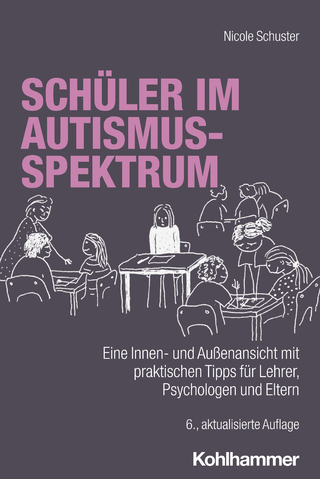
The Therapist's Notebook for Families
Routledge (Verlag)
978-0-415-72693-1 (ISBN)
The Therapist’s Notebook for Families, Second Edition, provides 72 solution-oriented activities for an array of challenging problems faced by mental health professionals when working with clients. The Therapist's Notebook offers clear, practical, easy-to-use exercises to help therapists work effectively and creatively with parents, adolescents, children, and families. Its solution-focused perspective provides a foundation based on collaboration, the utilization of client strengths, and the creation of possibilities to facilitate present and future change. The book is arranged in five parts, with 15 fully revised and 23 brand-new exercises.
Bob Bertolino, PhD, is an associate professor of rehabilitation counseling at Maryville University in St. Louis, Missouri. He is also senior clinical advisor at Youth In Need, Inc. and a senior associate at the International Center for Clinical Excellence. Bob has taught over 500 workshops throughout the United States and internationally and has authored or co-authored 14 books.
Introduction I. The Family as a Resource 1. The Therapist’s Notebook: Preparing for Working with Families 2. The Pyramid: Identifying Levels of Need 3. Reputation Matters: Examining the Culture of Therapy 4. Collaboration Keys: Strengthening the Alliance 5. Preferences: Eliciting Clients’ Ideas about Therapy 6. Who Are You? Qualities Within 7. Recollections: Finding What We Do Well 8. Factors: Influences on Problems and Solutions 9. Taking Stock: Creating a Family Inventory of Resources 10. More Than: Challenging Unhelpful Influences 11. More Like Whom? Speculating About My Parents 12. Significant: People Who Know or Have Known Me 13. Inside Job: Exploring Family Solutions 14. Inherited or Learned or Both? II. Getting Clear on Change 15. Cycling Through 16. The Language of Possibility 17. Invitations to Accountability: Separating Feeling and Doing 18. Translations: Using Action-Talk 19. Solution-Talk 20. Determining Goals: What Needs to Change? 21. Indications: Identifying Goal-Related Improvement 22. The Crystal Ball 23. The Time Machine 24. Movement: Signs of Progress 25. Scaling: Taking the Temperature of Change 26. Exploring Theories of Change III. Changing Views and Perspectives 27. Future-Talk: Acknowledgement and a Vision for the Future 28. Reviving The Soul: Spiritual Energy and Resources 29. Did You See That? Acknowledging Efforts 30. Family Views: Appreciating Different Perspectives 31. Teach Your Children 32. Request for Change 33. Catch ‘Em Doing Well 34. Seize the Moments: Identifying the Exceptions 35. Gaining the Upper Hand: Searching for Counterevidence 36. How Does That Help You? Reevaluating Viewpoints 37. What Would Einstein Say? Considering Alternative Views 38. The World as a Consultant: Learning from Experienced Others 39. Scene It: Movies as Life 40. Separating From Problems 41. The Big Picture 42. What’s My Mission? Finding a Meaning 43. Before Tomorrow: Finding a Vision for the Future IV. Changing Actions and Interactions 44. Our Lives as Patterns 45. Exception-Seeking: Changing Patters 46. Stay With It: Going Along with the Pattern 47. Try-Outs: Exploring the Benefits of Turning Patterns On and Off 48. Do Something Different: Experimenting with Pattern Interruptions 49. United We Stand: Creating Caregiving Agreement 50. Who’s Doing What? Sharing Household Responsibilities 51. Script It Out 52. Trouble with the Curve: Doing the Unexpected 53. Here, There, Not Everywhere: Change Some Aspect of Context 54. Something Different, Something New, Something Unpredictable 55. Remember When: Utilizing Past Solutions and Successes 56. Nothing’s Forever, It Just Seems That Way: Problem Wind-Downs and Endings 57. What Difference a Day Makes: Charting Solutions V. Keeping the Ball Rolling 58. Three Forward, Two Back 59. Putting the Brakes On: Keeping Things from Getting Worse 60. What Worked? Evaluating and Employing Successes 61. Parent Preparation, Parent Prevention 62. Traditions: Consistency, Continuity, and Connection 63. The Real World: Keeping an Eye on Between Session 64. Where’s the Evidence? Identifying the Facts of Change 65. Bring it to Light: Identify and Amplify Change 66. It Really is You! 67. Are We There Yet? Evaluating the Significance of Change 68. Self-Examination: Making the Most of Differences 69. The Scrapbook of Life 70. Certifiable 71. Pursuing the Future 72. Simply Said: The Gift of Gratitude
| Erscheint lt. Verlag | 5.10.2015 |
|---|---|
| Zusatzinfo | 1 Tables, black and white; 6 Illustrations, black and white |
| Verlagsort | London |
| Sprache | englisch |
| Maße | 210 x 280 mm |
| Gewicht | 635 g |
| Themenwelt | Geisteswissenschaften ► Psychologie ► Familien- / Systemische Therapie |
| Medizin / Pharmazie ► Medizinische Fachgebiete ► Psychiatrie / Psychotherapie | |
| Sozialwissenschaften ► Soziologie | |
| ISBN-10 | 0-415-72693-X / 041572693X |
| ISBN-13 | 978-0-415-72693-1 / 9780415726931 |
| Zustand | Neuware |
| Haben Sie eine Frage zum Produkt? |
aus dem Bereich


